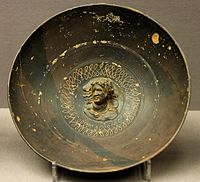cotyla
τό γε μὴν ἀόργητον ἀνδρός ἐστι σοφοῦ → and to be able also to subdue anger is the part of a wise man
Latin > English (Lewis & Short)
cŏtyla: ae, f., v. cotula.
Latin > French (Gaffiot 2016)
(1) cŏtўla ou cŏtŭla, æ, Mart. 8, 71, 8 et cŏtўlē, ēs, f., Anth. 486, 67 (κοτύλη), cotyle [servant d’une contenance d’1/2 setier, cf. Cato Agr. 146 ].
Latin > German (Georges)
cotyla od. cotyle, s. cotula.
Latin > English
cotyla cotylae N F :: small cup; liquid measure (= 6 cyathi/1 hemina/half sextarius/about 1/2 pint)
Wikipedia EN
In classical antiquity, the cotyla or cotyle (Gr κοτύλη) was a measure of capacity among the Romans and Greeks: by the former it was also called hemina; by the latter, τρυβλίον and ἡμίνα or ἡμίμνα. It was the half of the sextarius or ξέστης, and contained six cyathi, or nearly half a pint English.
Wikipedia IT
Il cotile o la cotila (in greco antico: κοτύλη, kotýle) era un'unità di misura di volume in uso nell'antica Grecia. Il cotile era un'antica unità di misura di capacità sia per i liquidi che per i solidi, il cui valore assoluto variava da una località all'altra da 0,21 litri a 0,33 litri. Nel sistema attico di Solone corrispondeva 0,27 litri.
Wikipedia ES
La kotyle o cótila (gr. κοτύλη) es una taza pequeña y profunda de dos asas de uso puramente doméstico en la Antigua Grecia. También se usaba este término para expresar su medida de capacidad, equivalente a c. 0,270 litros, la mitad del xestes griego y el sextario romano.
Wikipedia RU
Котила (др.-греч. κοτύλη) — единица измерения объёма у древних римлян и греков. Она составляла половину секстария или 4 хиникса. Котилами также назывались древнегреческие вазы, похожие по форме на скифосы. В современных единицах котила соответствовала объёму от 0,21 до 0,33 л (в зависимости от территории). В котилах чаще измерялся объём жидкости чем объем сыпучих веществ.

